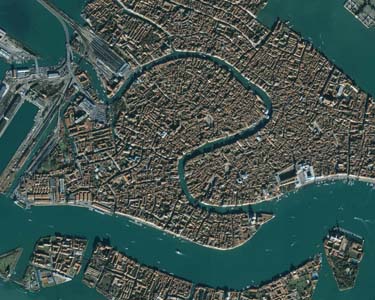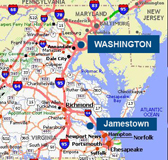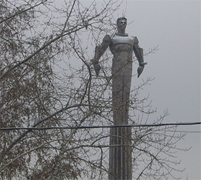
MOON BASE
EPISODE I
A Challenge for Humanity
Humanity has advanced, when it has
advanced, not because it has been sober, responsible, and cautious, but
because it has been playful, rebellious, and immature.
(Tom Robbins)
(Tom Robbins)
There
is no place on our planet more fitting than Venice for discussing the
challenge posed by a future human presence on the Moon. It is not
because of the spectacular architecture displayed all around nor of the
glorious past of the ancient Republic in sailing the distance to
faraway lands (in one word: exploration), not even the fact that Marco
Polo was born here. The keyword is logistics.
In Venice one travels from an “habitable island” to another on shuttle ferries and cargo ships moving along trajectories which immediately recall the laws of celestial mechanics. Braking is achieved by thrusting in a direction opposite to actual motion and also the timing is essential in order to avoid dangerous close approaches or collisions. Rendezvous and docking exercises are routinely performed by well trained pilots and crew members.
No wonder then that those who came to Venice for attending the first Moon Base Conference experienced two truly “moony” days. Talking passionately about inflatable habitats, space elevators, rectennas, science in low gravity, long-term strategies and short-term planning was followed by embarking on gently rolling lagoon ships to reach out for lunch or to attend the magnificent gala dinner in the Palazzo Pisani and sailing back to the hotel.
By the end of May 2005 the interest in the new vision for the exploration of the Moon, which had been raised by the US President speech a year before, was quickly spreading. The Venice Workshop was timely organized in order to pass on the message: take it seriously, this time we’ll be back to stay. This was the first challenge: to convince people (politicians, scientists, industrial partners, journalists and the public at large) that after a 30-year long worldwide lack of reliable lunar programs, things were rapidly changing. Our time, so different from the Apollo Moon race epoch, called for worldwide international cooperation. Yet political will is never sufficient to grant the future and a preliminary technical assessment is needed. In a sense, the Moon Base community which gathered in Venice started to answer to the four fundamental questions at the core of any intriguing spy story: What? Where? Why? When?
 The first two
questions are somehow
connected: where to go depends on what to do or what you are expected
to find once you are there (and vice-versa). A great deal of efforts
have been dedicated to identifying the most favourable location for a
human settlement on the Moon. General consensus is on polar sites, for
many reasons. Energy, for example, is a top issue. The 1:1 spin-orbit
synchronous resonance which rules lunar phases is responsible for the
Moon showing always the same face to Earth. But the usual way of
referring to the other lunar emisphere as the “dark side of the Moon”
can be misleading. The 29-day lunar month is also the length of a lunar
day, which implies that most of the lunar surface experiences
alternating continuous periods of daylight and night time lasting each
a little more than two weeks. This, in turn, means facing a number of
brand new technical problems – never addressed by the quick Apollo
missions – for surviving the long lunar night.
The first two
questions are somehow
connected: where to go depends on what to do or what you are expected
to find once you are there (and vice-versa). A great deal of efforts
have been dedicated to identifying the most favourable location for a
human settlement on the Moon. General consensus is on polar sites, for
many reasons. Energy, for example, is a top issue. The 1:1 spin-orbit
synchronous resonance which rules lunar phases is responsible for the
Moon showing always the same face to Earth. But the usual way of
referring to the other lunar emisphere as the “dark side of the Moon”
can be misleading. The 29-day lunar month is also the length of a lunar
day, which implies that most of the lunar surface experiences
alternating continuous periods of daylight and night time lasting each
a little more than two weeks. This, in turn, means facing a number of
brand new technical problems – never addressed by the quick Apollo
missions – for surviving the long lunar night.
A possible way out relies on the consideration that the low obliquity of the Moon (1.5 degrees) coupled with the 5 degree inclination of her orbital plane on the ecliptic, accounts for reduced polar circles. The steep borders of impact craters close to the poles could then raise high enough to remain in sunlight for up to 90% of the lunar month, thus providing an almost continuous source of solar energy.
Conversely, the bottom of high latitude craters may hide regions never touched by the warmth of the Sun. The existence of such “cold traps” is even more significant for exploration. If large ice reservoirs implanted by cometary impacts are still there, a source of everything that can be made out of hydrogen and oxygen (air for breathing, rocket fuel, drinkable water, electricity) is at hand. First spotted by the radar on board the last generation lunar orbiters, they still await confirmation. But there is little doubt that it is a finding that could change dramatically the whole lunar exploration scenario.
Brainstorming on the motivations behind the challenge posed by a Moon Base was, of course, one of the major issues. Whether for the good or for the bad, the word “exploration” seems to have lost its self-explanatory meaning as well as its confidence of acting for the benefit of humankind. Actually the real question was twofold: why should we go back to the Moon? and why with humans and not just relying on highly computerized robotics?
A wide spectrum of answers was given, ranging from more or less known historical examples to apparently naïve statements such as “if not for us, who else then?”. Big science is always a good start but unfortunately its own nature is of being unable as well of knowing in advance which direction major discoveries come from. On more technological grounds, one of the most appealing reasons is provided by the possibility of finding on the Moon the long-sought clean and unlimited energy source for the Earth. Lunar solar power plants foresee covering with solar panels wide regions on the Moon and then transferring energy to our planet by microwave radiation. Conversion back to electricity is done by ground stations equipped with the so-called “rectennas”.
Answering “when?” this is all going to happen is notoriously risky for everyone working on long-term space enterprises. Nevertheless Karl Heiss of High Frontiers, one of the promoters of the Moon Base Conference, is reported to have said that if by 2015 men have not set foot again on the Moon, then the whole audience would be entitled to write to him a formal letter of complaint!
In Venice one travels from an “habitable island” to another on shuttle ferries and cargo ships moving along trajectories which immediately recall the laws of celestial mechanics. Braking is achieved by thrusting in a direction opposite to actual motion and also the timing is essential in order to avoid dangerous close approaches or collisions. Rendezvous and docking exercises are routinely performed by well trained pilots and crew members.
No wonder then that those who came to Venice for attending the first Moon Base Conference experienced two truly “moony” days. Talking passionately about inflatable habitats, space elevators, rectennas, science in low gravity, long-term strategies and short-term planning was followed by embarking on gently rolling lagoon ships to reach out for lunch or to attend the magnificent gala dinner in the Palazzo Pisani and sailing back to the hotel.
By the end of May 2005 the interest in the new vision for the exploration of the Moon, which had been raised by the US President speech a year before, was quickly spreading. The Venice Workshop was timely organized in order to pass on the message: take it seriously, this time we’ll be back to stay. This was the first challenge: to convince people (politicians, scientists, industrial partners, journalists and the public at large) that after a 30-year long worldwide lack of reliable lunar programs, things were rapidly changing. Our time, so different from the Apollo Moon race epoch, called for worldwide international cooperation. Yet political will is never sufficient to grant the future and a preliminary technical assessment is needed. In a sense, the Moon Base community which gathered in Venice started to answer to the four fundamental questions at the core of any intriguing spy story: What? Where? Why? When?
 The first two
questions are somehow
connected: where to go depends on what to do or what you are expected
to find once you are there (and vice-versa). A great deal of efforts
have been dedicated to identifying the most favourable location for a
human settlement on the Moon. General consensus is on polar sites, for
many reasons. Energy, for example, is a top issue. The 1:1 spin-orbit
synchronous resonance which rules lunar phases is responsible for the
Moon showing always the same face to Earth. But the usual way of
referring to the other lunar emisphere as the “dark side of the Moon”
can be misleading. The 29-day lunar month is also the length of a lunar
day, which implies that most of the lunar surface experiences
alternating continuous periods of daylight and night time lasting each
a little more than two weeks. This, in turn, means facing a number of
brand new technical problems – never addressed by the quick Apollo
missions – for surviving the long lunar night.
The first two
questions are somehow
connected: where to go depends on what to do or what you are expected
to find once you are there (and vice-versa). A great deal of efforts
have been dedicated to identifying the most favourable location for a
human settlement on the Moon. General consensus is on polar sites, for
many reasons. Energy, for example, is a top issue. The 1:1 spin-orbit
synchronous resonance which rules lunar phases is responsible for the
Moon showing always the same face to Earth. But the usual way of
referring to the other lunar emisphere as the “dark side of the Moon”
can be misleading. The 29-day lunar month is also the length of a lunar
day, which implies that most of the lunar surface experiences
alternating continuous periods of daylight and night time lasting each
a little more than two weeks. This, in turn, means facing a number of
brand new technical problems – never addressed by the quick Apollo
missions – for surviving the long lunar night. A possible way out relies on the consideration that the low obliquity of the Moon (1.5 degrees) coupled with the 5 degree inclination of her orbital plane on the ecliptic, accounts for reduced polar circles. The steep borders of impact craters close to the poles could then raise high enough to remain in sunlight for up to 90% of the lunar month, thus providing an almost continuous source of solar energy.
Conversely, the bottom of high latitude craters may hide regions never touched by the warmth of the Sun. The existence of such “cold traps” is even more significant for exploration. If large ice reservoirs implanted by cometary impacts are still there, a source of everything that can be made out of hydrogen and oxygen (air for breathing, rocket fuel, drinkable water, electricity) is at hand. First spotted by the radar on board the last generation lunar orbiters, they still await confirmation. But there is little doubt that it is a finding that could change dramatically the whole lunar exploration scenario.
Brainstorming on the motivations behind the challenge posed by a Moon Base was, of course, one of the major issues. Whether for the good or for the bad, the word “exploration” seems to have lost its self-explanatory meaning as well as its confidence of acting for the benefit of humankind. Actually the real question was twofold: why should we go back to the Moon? and why with humans and not just relying on highly computerized robotics?
A wide spectrum of answers was given, ranging from more or less known historical examples to apparently naïve statements such as “if not for us, who else then?”. Big science is always a good start but unfortunately its own nature is of being unable as well of knowing in advance which direction major discoveries come from. On more technological grounds, one of the most appealing reasons is provided by the possibility of finding on the Moon the long-sought clean and unlimited energy source for the Earth. Lunar solar power plants foresee covering with solar panels wide regions on the Moon and then transferring energy to our planet by microwave radiation. Conversion back to electricity is done by ground stations equipped with the so-called “rectennas”.
Answering “when?” this is all going to happen is notoriously risky for everyone working on long-term space enterprises. Nevertheless Karl Heiss of High Frontiers, one of the promoters of the Moon Base Conference, is reported to have said that if by 2015 men have not set foot again on the Moon, then the whole audience would be entitled to write to him a formal letter of complaint!
ettore perozzi


